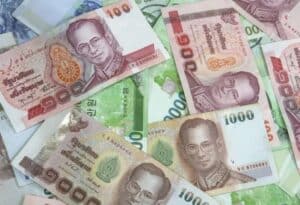Thailand, a country in mainland Southeast Asia, is well-known for its delectable cuisine, sacred temples, stunning beaches, and warm inhabitants. Formerly known as Siam and now officially known as the Kingdom of Thailand, it is home to the Thai baht, a vibrant currency.
The Thai baht is printed by the Bank of Thailand in Bangkok (THB). Fun fact: The baht ranks among the top 12 most utilized currencies worldwide.
What more should you know about Thailand’s monetary system, though, before converting Thai cash to US dollars or the other way around?
History and Origins
Thailand previously utilized shells, baked clay coins, and pot duang as legal money before adopting flat banknotes and coins.
Thailand had established diplomatic ties with important Western nations and had put in place a free trade system under the reign of King Mongkut. As trade rose substantially, so did the need for money, and Pot Duang’s production could no longer keep up with the demand. As a result, King Mongkut issued the first paper currency in 1853, known as Mai, but it was not very successful because most people continued to utilize Pot Duang.
Low-value copper coins became rare with the accession of King Chulalongkorn in 1873 as the value of tin and copper on the global market increased above the face value of the coins. Due to the scarcity, people began to trust the pee, a form of currency utilized in casinos. To avoid its use, King Chulalongkorn ordered the use of low-value paper money called Att Kradat while he awaited the arrival of the copper coins that had been imported from England and would subsequently be taken out of circulation in 1875.
Due to the government’s inability to supply Thai coins in response to the growth of the economy and trade, three foreign commercial banks were each given authorization to operate and issue banknotes in 1889, 1898, and 1899 to speed up the settlement of obligations between the bank and its clients.
Due to ineffective banknote management, the government never issued the Ngoen Kradat Luang or Treasury Notes that were intended to be issued in 1890.
King Chulalongkorn’s reign in 1902 saw the official opening of the Thai Department of Technology, which is now part of the Ministry of Finance. The 23rd of September, 1902, saw the introduction of contemporary Thai banknotes, and it was this department’s obligation to issue and exchange such notes.
Thailand’s basic currency
Thailand’s currency is available in coins and banknotes, like many other currencies. Paper banknotes are available in the following denominations: 20, 50, 100, 500, and 1,000 baht, with 100 baht being the most often accepted.
The baht is divided into 100 satangs by the Thai central bank. Thai coins are available in the following values: 1, 2, 5, 10, 25, and 50 satangs. The most common coin is the 10-satang coin.
The most common names for the currency are the Thai baht and simply baht. Its symbol is an uppercase B with a perpendicular line running through the middle (). The three-letter THB symbol designates the baht in foreign exchange markets.
The Thai baht: Interesting facts
Check out these fascinating facts about the Thai baht, whether you need to send or exchange it or you just want to know more about this Southeast Asian currency.
Please read: Facts and Trivia about the Yen Currency for Travellers
Every banknote has a king on it
Thailand’s reigning monarch, King Maha Vajiralongkorn, is shown on the 20-, 50-, and 100-baht banknotes. The most recent versions of the 500 and 1,000 baht banknotes were released in 2018 on the birthday of King Maha Vajiralongkorn.
The fundamental colors and sizes of the notes are the same as before, while the back designs include pictures of Thailand’s monarchs, arranged chronologically.
Unique cotton is used to create the baht
The Thai baht is made from unique and particularly durable cotton material. When handling Thai currency, it is simpler to distinguish between each banknote denomination because each has a different thickness and feel.
In contrast to other currencies, the Bank of Thailand uses an intaglio printing technique that leaves the print slightly elevated.
Arabic and Thai numerals are used frequently to display the denominations. Each banknote has Arabic numbers tucked down in the lower-left corner.
You can’t step on a baht
People in the United States might not treat bills and coins with the utmost care. That is not the situation in Thailand, though. The nation has a strong national statute, called the lese-majeste law, that forbids insults to its monarchy.
Any verbal, physical, or written act that shows contempt for the monarch or any member of the royal family is forbidden by this law. This regulation covers the handling of currency because all of Thailand’s money features the king’s or a deceased royal family member’s portrait.
For instance, Thailand may have laws against the following actions:
- A penny was stepped on.
- stepping on some cash
- altering a banknote by burning, shredding, or writing
On the other hand, as a sign of respect for the king, many stores in Thailand display a few smaller baht bills.
Conclusion
Consult an exchange rate guide for further information on understanding exchange rates. For the most recent exchange rates for Thai baht, you can also check with your bank or preferred money transfer service.
For instance, if you visit our site and select Thailand as your destination, you may view the most recent exchange rates for USD, GBP, and other currencies.
Although the Thai baht has undergone numerous adjustments over the years, it remains one of the world’s most traded currencies. It’s safer to use a money transfer provider when sending money to loved ones in the Philippines from Thailand, especially if you’ll be sending sizable amounts at once.
Transferring money internationally is simple with ALLCASH. Low fees, a favorable exchange rate, and the option to follow your transfer at every stage are all advantages.





